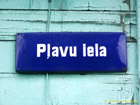1300 ha of floodplain meadows restored within a year Meadow restoration activities are still in progress; in the first year of the project, 60 contracts have been signed with land managers for restoration of over 1300ha of floodplain meadows for the total sum of 79 thousand Lats.  | | "Street of meadows" - | | street name in Ilūkste | 1300 ha of floodplain meadows restored within a year Meadow restoration activities are still in progress; in the first year of the project, 60 contracts have been signed with land managers for restoration of over 1300ha of floodplain meadows for the total sum of 79 thousand Lats. The project on Restoration of Latvian floodplains for EU priority species and habitats financed through the EU LIFE-Nature program and the UNDP (particularly for activities within the North Vidzeme Biosphere Reserve) started on 1 October 2004. Soon it will celebrate its first year. After the first mowing season (According to the regulations of the Rural Support Service (RSS), mowing is permitted from 10 July until 10 September. In this project, mowing is part of restoration activities and thus not limited by the end date; it is rather regulated by nature and weather conditions. Yet, the earliest mowing date is set later than that of the RSS on 15 July. Explanation is given at the end of this article.) most of the meadows have undergone the so called primary mowing. Primary or initial mowing is applied to overgrown meadows, those that have been abandoned for a number of years, and where mowing is particularly hard and complicated. For instance, meadows that had just been cleared of bushes and the restored area then has to be mown as a new meadow. Many of the meadows were is a critical state, where prior cutting of bushes or even felling of small trees had to take place. These activities were started already in winter and continued until spring flooding, if not stopped by snow. Meadow restoration was temporarily stopped during bird breeding season from 1 April until 15 July. Future management of the restored meadows will be supported by the Agro-environmental program; land managers responsibilities are set in their contracts and they are motivated to receive payments for management of biologically valuable grasslands. Aside from restoration of floodplains, the project has also undertaken clearing bushes around  | | Relaxation after | | cutting of bushes | | at Burtnieks | individual oak trees. This has taken place in smaller sites (ca. 18 ha) of wooded meadows on the banks of the Padedze River. Currently work is ongoing on fencing Burtnieki horse pasture in the Meadows of Lake Burtnieks Nature Reserve. The largest number of contracts (12) for restoration of meadows has been signed in the Dviete Floodplains Nature Park. However, there are many landowners there with comparatively small land parcels belonging to them. The season was deemed rather successful by I. Račinska, the chairperson of the Project Steering Group meeting held in Ķempēni. Yet, on several occasions cutting of bushes was halted by either a thick snow cover or by flooding. Just to remind, ca. 2400 ha of overgrown floodplain meadows are to be restored as part of this project. For centuries mowing has been the key form of meadow management, which has allowed maintaining and developing meadow habitats is Latvia. Historically,  | | Restoored Fennoscandian wooded | | meadows at Pededze River | meadows in Latvia, and in particular the so called distant meadows on river banks that usually were floodplain meadows, were mown late: in July. Earlier mowing was not possible due to technical capabilities of those times. This was one of the key aspects that allowed development and existence of biological diversity there after July chicks of many bird species could already fly. Besides, in the past when meadows were mown using a scythe, they were mown gradually. People simply could not mow entire meadows at once, which was favorable for birds; if disturbed, birds could leave parts that were being worked on and retreat to meadows that were still not mowed or where vegetation has re-grown. Agronomists have found that meadows of agricultural use should be mown earlier when they produce the highest amount of digestible nutrients per area unit. Besides, regeneration process is faster for grass cut earlier, as in early development stage they have more vegetative shoots. Nevertheless, there are plants for which the best mowing phase starts later. Meadow birds, on the other hand, are harmed by early mowing. In the process their nests are often destroyed and chicks not able to fly are killed. It particularly concerns species that start breeding late like corn crake and great snipe. Due to modern technology, today meadows can be mown early and all at once thus harming meadow birds. Hence, protection of these birds should be ensured. | 
| | Fragmentation of meadow area | | in Burga meadows | | 






